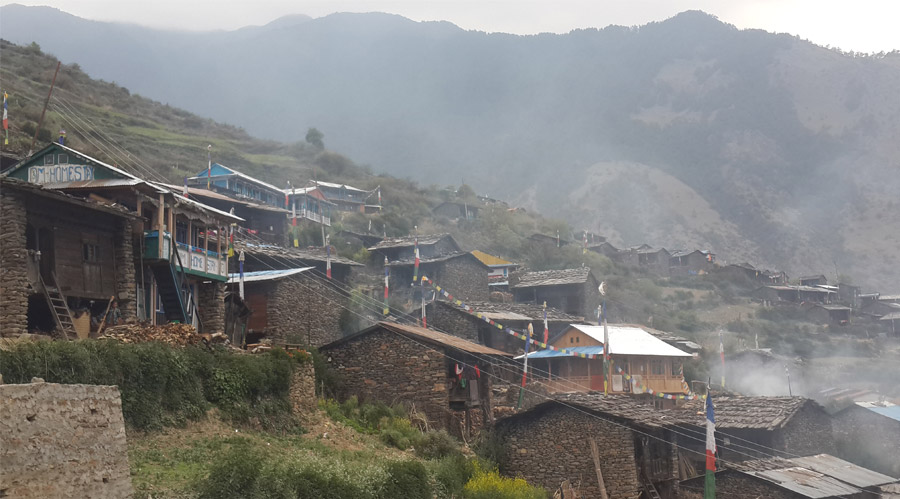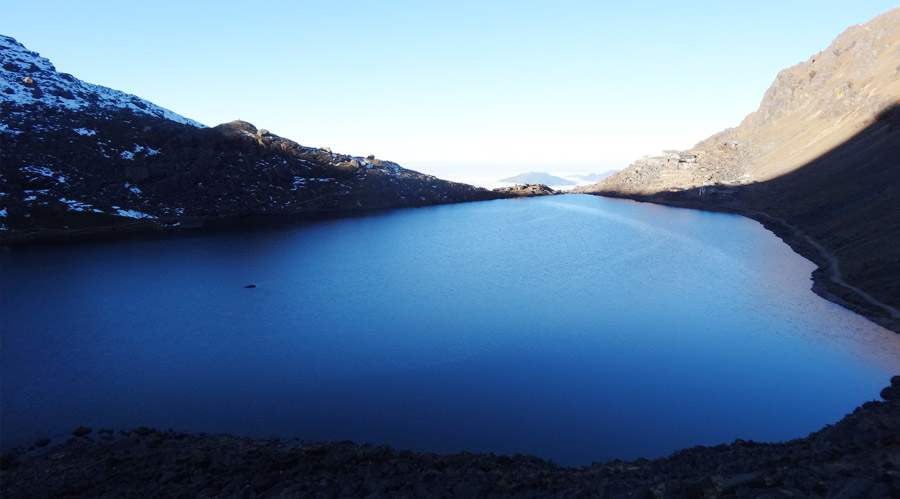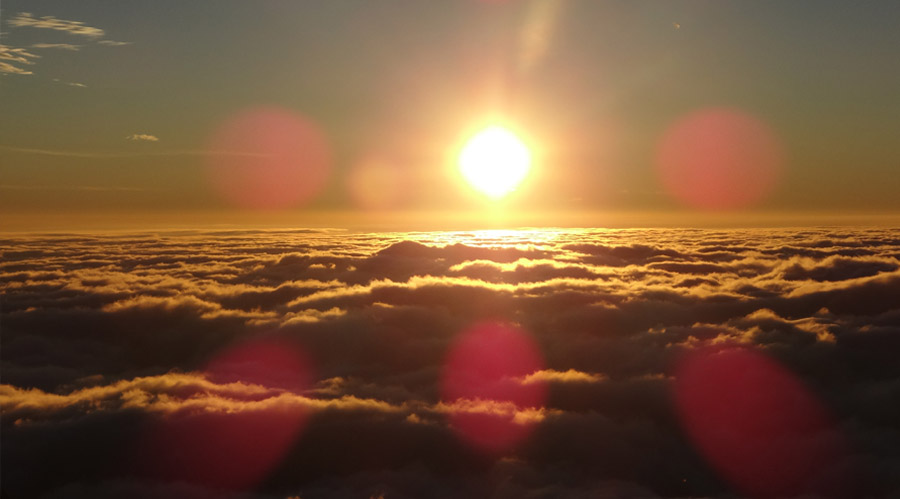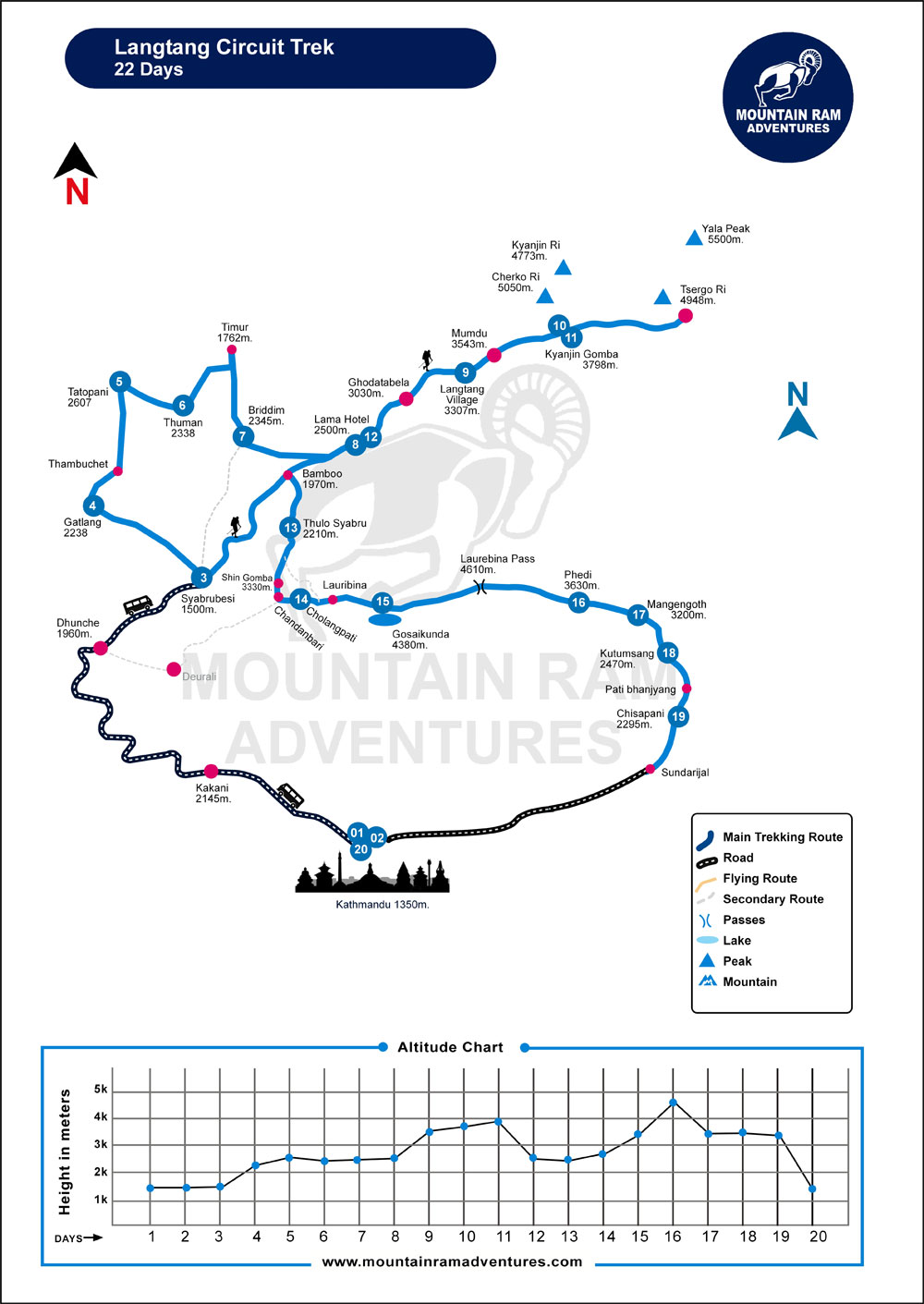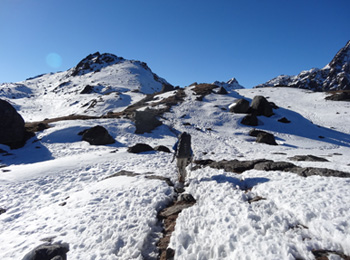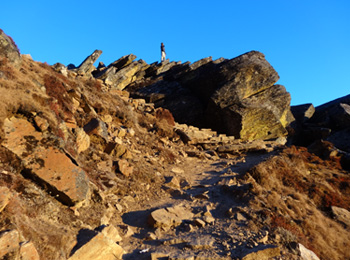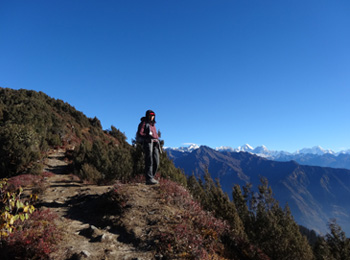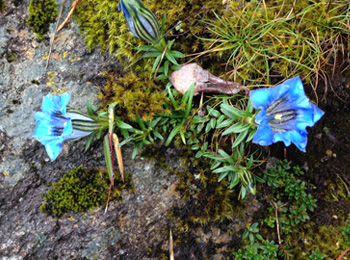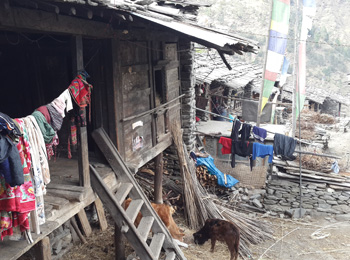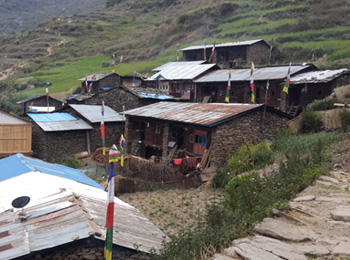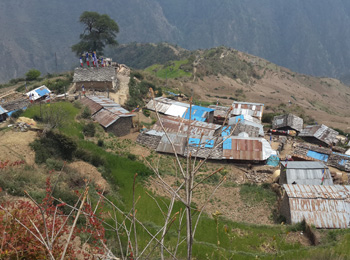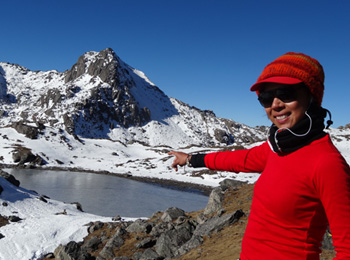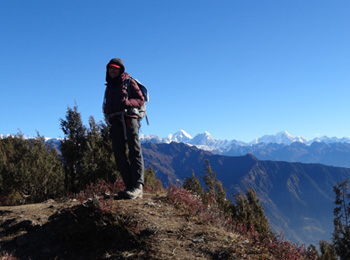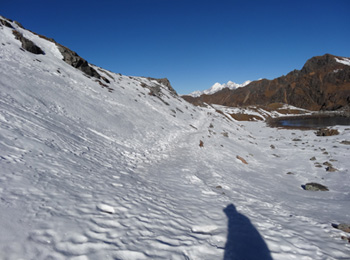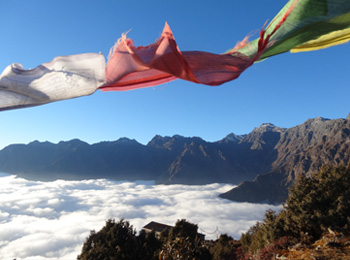- +977 9851074270
- info@mountainramadventures.com
Trip Highlights
- Explore all the major trekking routes of the Langtang region in one package
- The ultimate trekking adventure in the beautiful Langtang Himalayas
- Explore the diverse flora and fauna of Langtang National Park and Shivapuri National Park
- Get to know the Tamang community closely as you spend nights in their home
- Trek through picturesque villages, lush rhododendron forests, and vibrant valleys
- Enjoy natural hot springs in Tatopani
- Unwind while enjoying the stunning landscape at the shore of Gosaikunda lake
- Cross the Lauribina pass and explore the gorgeous Helmabu region
- A perfect trekking program in Nepal for those seeking a lifetime adventure in the Himalayas, especially for experienced trekkers
- The trail is packed with rushing suspension bridges, cascading waterfalls, glistening glaciers, rocky gorges, ancient stupas, and colorful prayer flags
- Witness different landscapes as the elevation rises and enjoy breathtaking views of mountains like Langtang Lirung, Ganesh Himal, Shishapangma, Scout Peak, etc
- Hike to Tserko Ri and visit a local cheese factory
Detail About Langtang Circuit Trek
Langtang circuit trek includes all the major trekking routes of the beautiful Langtang region - Tamang heritage trail, Langtang valley trail, Gosaikunda lake trail, and Helambu trail. It is the ultimate trekking package in the Langtang region that lets you explore the Tamang community, stunning Langtang valley, holy Gosaikunda lake (4,380 m/14,370 ft), challenging Lauribina pass, and the gorgeous Helambu region. This is a 21 days trekking program in Nepal for those seeking a lifetime adventure in the Himalayas.
This trek is especially for trekkers with previous experience of hiking or trekking. However, fit individuals can also join us on the Langtang circuit trek 2025/2026 departures without previous trekking experience. Langtang is one of the closest trekking regions to Kathmandu. Unlike the famous trekking routes, you can reach the starting point of the Langtang circuit trail via a comfortable 7-8 hours ride. This makes trekking in the Langtang region very compelling.
The Langtang circuit trek lets you explore the wilderness of Langtang National Park and Shivapuri National Park. On this trek, you will explore verdant valleys and forested hills. Rushing suspension bridges, cascading waterfalls, glistening glaciers, rocky gorges, ancient stupas, colorful prayer flags, and snow-capped mountains are essential elements of Langtang circuit trekking. The trail is adventurous, isolated, and serene.
The Langtang circuit trek from Kathmandu is the quickest way to travel in the majestic Himalayas without spending much money. The upper part of the trail is dotted with towering Himalayan mountains like Ganesh Himal ( 7,422 m/24,350 ft), Langtang Lirung (7,234 m/23,734 ft), Dorje Lakpa (6,966 m/22,854 ft), Ganchenpo (6,387 m/20,955 ft), Scout Peak (5,710 m/18,733 ft), Naya Kanga (5,846 m/19,180 ft), Shishapangma (8,027 m/26,335 ft), and many others.
You will spend a long time in the mountains during the Langtang circuit trek, which allows you to have a close understanding of the locals. Sherpas and Tamangs are the two main inhabitants of the Langtang region. Tamangs stand out because of their numbers and ancestry to Tibetans. Their culture, beliefs, language, food, and kindness will win your heart. As the Langtang circuit trek involves guesthouse accommodation, you will stay quite close to them.
Our Langtang circuit trek itinerary has ample acclimatization days with exciting hiking options to Tserko Ri, Kyanjin Ri, etc. Along the way, you will visit local schools, health posts, and yak cheese factories. This is one of the best Langtang circuit trek itineraries, but you can freely customize the package as per your requirements with us. Enjoy a genuine Langtang circuit trek cost with us at Mountain Ram Adventures with no hidden charges and trek with a friendly and reliable native guide.
Experience the Himalayas at its best on our special Langtang circuit trek. Get to know Nepalese culture and people closely. Make lifelong memories and friends. The Langtang circuit trek is only the start of your journey in Nepal, and we cannot wait to be part of this beginning!
Gosaikunda Lake
Gosaikunda is a glacial lake. It is created by the melting waters of the Langtang glacier. This lake is part of a larger network of lakes. However, Gosaikunda stands out as the most prominent and spectacular of them all. Gosaikunda lake is surrounded by rugged, snow-capped peaks and is fed by crystal-clear mountain streams, making it a picture-perfect destination for trekkers and photographers.
For centuries, Gosaikunda has been a place of deep religious values. Hindus believe that the lake was created by Lord Shiva when he thrust his trident (Trishul) into the ground to quench his thirst after consuming poison during the churning of the ocean. As a result, Gosaikunda is often referred to as the "Lake of Lord Shiva." Every year, during the Janai Purnima festival, which usually falls in August, Hindu pilgrims visit this holy lake to take a holy dip in its sacred waters.
Buddhists also hold Gosaikunda in high regard. According to Buddhist folklore, this mystical lake is home to the protective deity Dorje Lekpa. It is also believed to be a place where Guru Rinpoche, the founder of Tibetan Buddhism, meditated. Thus, Gosaikunda lake is a place of meditation and spiritual retreat for Buddhists.
Gosaikunda is not only a cultural gem but also a crucial ecological habitat. The surrounding area is home to diverse flora and fauna, including rare and endangered species such as red pandas, snow leopards, and various species of pheasants. The Langtang National Park, which encompasses Gosaikunda, plays a vital role in the conservation of these species and their fragile ecosystems.
Langtang circuit trek distance and terrain
On average, a standard Langtang circuit trek typically covers a distance of approximately 225 kilometers (140 miles) over a span of 21 days, depending on the starting and ending points and the side trips taken along the way. The approximate trekking distance in miles falls within the range of 65 to 75 miles. Side trips to Tserko Ri (5,033 m/16,512 ft), Lauribina Pass (4,610 m/15,124 ft), or other nearby attractions can add extra mileage to the trek.
The Langtang circuit trek route offers a remarkable journey through a range of terrains. The trek begins with lush, subtropical forests filled with rhododendron, oak, and pine trees. These verdant woodlands are home to a variety of wildlife, including monkeys, birds, and even the elusive red panda. As you ascend, you'll pass through terraced fields and lush forests. The trail follows alongside the Langtang River and its tributaries, leading you through river valleys dotted with massive boulders.
As you climb higher, the landscape transitions into alpine meadows. These open spaces are carpeted with colorful wildflowers and lush green grass. Likewise, you will navigate a mountain pass and different hilltops (bhanjyang) along the trail. The upper part of the trail traverses glacial moraines and uneven, steep tracks.
Langtang circuit trek preparation
The Langtang circuit trek demands both physical and mental preparation to ensure an enjoyable experience. Cardiovascular exercises, strength training, and flexibility workouts will help you prepare physically for the trek. These exercises will significantly boost your stamina and resilience. Incorporating hikes on uneven terrains and long walks into your routine will mimic the trekking conditions and help you adapt to long hours on your feet.
Understand that the Langtang circuit trekking is an opportunity to disconnect from technology and immerse yourself in the pristine wilderness. Embrace the serenity of nature, as you may not have access to the conveniences of modern life. Be ready to adjust to new meal options and accommodations that may differ from your usual comforts.
Maintain a positive attitude throughout the trek. Challenges are inevitable during the Langtang circuit trek 21 days, but your outlook can make all the difference!
Best Langtang circuit trek package for 2025/2026 with native guides and porters
With us by your side, nothing remains beyond reach in the mesmerizing landscapes of Nepal. Our meticulously crafted Langtang circuit trek package encompasses all the essential elements while maintaining the flexibility to tailor the journey to your specific budget and preferences. You can book the Langtang circuit trek 2025/2026 departure with us now as our bookings are open.
For groups of six or more trekkers, we have special discounts, making our Langtang circuit trek package even more enticing. We believe that exceptional adventures should be accessible to all, and we are here to make that a reality for you. For more information, contact us anytime.
Benefits of using Mountain Ram Adventures for Langtang circuit trekking
We, Mountain Ram Adventures, have been organizing treks and tours in Nepal for more than 20 years. We know all the trekking routes in Nepal and have a huge network of mountain guides and porters who help us make our adventure journey safe and smooth. If you choose us to do the Langtang circuit trek in Nepal, our team will be there for you from the start to the finish of the journey.
We assure you a safe Langtang circuit trek at the best price and top-notch service. Our Langtang circuit trek itinerary is customizable. We do not have any hidden costs or policies, which makes us very reliable and trustworthy. You can check our YouTube videos to know how trekking with us feels like. We, Mountain Ram Adventures, are one of the reputable trekking agencies in Nepal.
Alternate trekking and tour packages in Nepal
Nepal has a lot to offer whether you are seeking adventure, culture immersion, or a luxury holiday. We have a range of trekking and tour packages in Nepal to fit all ages of trekkers. Some of our best trekking packages are- the Everest base camp trek, Annapunra base camp trek, Annapunra circuit trek, Everest Gokyo lake trek, Manaslu circuit trek, Upper Mustang trek, etc.
Similarly, you can check out our tour packages here. We also have jungle safari, rafting, and paragliding options. For travelers who are short on time but wish to see the beauty of the Himalayas can opt for our EBC helicopter tour, ABC helicopter tour, and Gosaikunda lake helicopter tour.
Let's be responsible for our waste- Clean Travel
In the serene landscapes of the Langtang region, even the smallest choices we make can have a profound impact on the environment. Trekking with us means you will be practicing eco-friendly and sustainable travel. Our team will provide you necessary guidance on how you can lower or impact during trekking and what you can do to leave the trail as it was when you arrived.
Below are a few things that you should consider to make the Langtang circuit trek 21 days a sustainable venture:
- Embrace the reusable: Opt for a refillable water bottle to minimize the use of single-use plastic and reduce waste.
- Eco-friendly essentials: Pack biodegradable toiletries and consider carrying reusable cutlery and food containers to cut down on disposable waste.
- Say no to single-use plastics: Refrain from using single-use plastics such as plastic bags and straws during trekking.
- Leave no trace: Make it a rule to leave no trace behind. Dispose of all waste responsibly, including food wrappers, tissues, and other packaging.
- Waste sorting: In areas equipped with waste disposal facilities, utilize designated waste bins for different types of waste – recyclables, non-recyclables, and organic waste.
Help us improve our service by giving your feedback
At Mountain Ram Adventures, we care a lot about guest satisfaction. Your feedback serves as the compass guiding us toward excellence. Our customer service team is always eager to receive your feedback, suggestions, or concerns. Rest assured, your words will not merely be heard but swiftly acted upon to resolve any issues that may arise. You can leave reviews on our website, social media platforms, or travel review websites.
Trip Itinerary Expand All
- 1,400 m/4,600 ft
- Hotel
Upon your arrival in Kathmandu, the team of Mountain Ram Adventures will pick you up from the international airport. They will welcome you on our behalf and drop you at the hotel. The ride will be hassle-free for you as our team will assist you with luggage. Check in at the hotel and rest. You have the left of the day free in Kathmandu. It is a great time to unpack and explore the bustling streets of Thamel on your own.
- Breakfast only
- Hotel
Today, you will spend the day visiting some historical sites in Kathmandu and preparing for the trek. The tour starts after breakfast. Our tour guide will meet you in the hotel lobby and take you to four different monuments. During the tour, we will use a comfortable four-wheeler as per the group size. First, we will visit the famous Monkey Temple, situated at the top of a hill. This place offers a fantastic aerial view of Kathmandu.
From here, we will visit the Pashupatinath Temple, one of the most important pilgrimage sites in Nepal. The tour then continues to Bouddha. Bouddha is the largest stupa in Nepal. The soothing environment of this place will win your heart. The last place we will visit during the tour is Kathmandu Durbar Square. It used to be a royal residence and now serves as an open museum.
During the tour, the guide will brief you about the monuments and their significance in Nepal's history. You will get to have a glimpse of Nepali art, architecture, and culture. You will return to the hotel and have a lung. Have a rest for a couple of hours and later meet us in our office. The trek guide will brief the route and help you with the final packing. We will double-check all the trekking necessities and needed documents.
- 7-8 hours
- Breakfast, lunch & dinner
- 1,500 m/4,921 ft
- Guesthouse
The Langtang circuit trek starts today. Our first goal is to reach the starting point of the trail, which is Syabrubesi. From Kathmandu, we will take a long drive following lush green hills and rivers. The ride offers fantastic views of Ganesh Himal, Annapurna, and Manaslu, along with superb landscapes. From Dhunche, the road is bumpy till Syabrubesi.
- 5 hours
- Breakfast, lunch & dinner
- 2,238 m/7,342 ft
- Breakfast, lunch & dinner
For the next 3-4 days, we will be trekking close to the settlements of Tamangs. This part of our trek will let us have a glimpse of the daily lifestyle and culture of Tamangs, one of the major residents of the Langtang region. The trail from Syabrubesi goes through pastures and lush forests. You will come across beautiful waterfalls and rivers on the way. Syabrubesi to Gatlang is almost 12.1 kilometers (7.5 miles) distance.
- 5-6 hours
- Breakfast, lunch & dinner
- 2,607 m/8,553 ft
- Guesthouse
Leaving Gatlang, we will continue the trek to Tatopani. Early in the morning, we will have a delicious breakfast and visit a monastery. After that, we will begin trekking, following a downhill trail that leads to a junction. On the way, we will trek past many stupas. Further, we will follow an uphill route to Chilime and keep ascending past waterfalls to Tatopani.
Tatopani is famous for its natural hot springs. We can enjoy natural hot springs here by paying a few extra bucks. It will relieve our sore muscles and is also good for curing any skin-related issues. We can see an excellent view of Langtang Range and Ganesh Himal from here.
- 7 hours
- Breakfast, lunch & dinner
- 2,338 m/7,670 ft
- Guesthouse
Today, we will trek to Thuman, a lovely village resided by Tamangs. Leaving Tatopani, we will ascend to a viewpoint and gradually descend to Nagthali at 3,165 meters. The views of Ganesh Himal, Langtang Range, Scout Peak, and Naya Kanga are phenomenal from here. The trail from Nagthali further descends to Thuman for the night stay. Your time in these villages will provide you with a chance to have intimate encounters with the locals and get to know them closely.
- 6 hours
- Breakfast, lunch & dinner
- 2,229 m/7,313 ft
- Guesthouse
Leaving Thuman, we will cross a suspension bridge over the Bhote Koshi river and gradually trek past a stupa. The trail descends through the forested path to Bridim for the night stay. This is an old trade route. Bridim is also resided by Tamangs and a few other communities. This is the last village on the Tamang Heritage Trail, and from here onwards, we will head to the Langtang valley.
*Note: If you have an extra day, you can trek to Rasuwagadhi via Timure. Rasuwagadhi is the last village before the Nepal-Tibet border. It is also a historical war place with watch towers and a fortress.
- 5-6 hours
- Breakfast, lunch & dinner
- 2,480 m/8,136 ft
- Guesthouse
From Bridim, the trail descends through lush forests of rhododendrons and bamboo. It is a long forested path with some small settlements on the way. The mountain views are beautiful, like always. We may come across Langur monkeys, mules, and yaks while trekking. Further, trekking past Sherpagaon at 2,563 meters, we will continue to Rimche (2,485 m) and ascend to Lama Hotel along the Langtang Khola.
- 6 hours
- Breakfast, lunch & dinner
- 3,430 m/11,253 ft
- Guesthouse
The trail continues along the Langtang Khola and ascends to Chhunama (2,790 m). We will trek through dense forests and verdant hillsides. Leaving Chhunama, we will cross a suspension bridge over Langtang Khola and trek to Ghodatabela. At Ghodatabela, we will also register our permits at the police checkpost.
Crossing another bridge over the same river, we will resume trekking and pass by Langtang Gompa before reaching Langtang village. Langtang village is beautiful with hills and mountains like Langtang Lirung, Langtang II, Scout Peak, etc surrounding it.
- 6 hours
- Breakfast, lunch & dinner
- 3,865 m/12,680 ft
- Guesthouse
From Langtang village, the trail goes past yak pastures and a few tiny settlements. We will trek past mani stone wall and reach Mundu. Further, we will come across many scattered stupas and gradually ascend to Kyanjin Gompa, crossing a suspension bridge. Kyanjin Gompa is one of the important religious points in the Langtang region. We will also spend an acclimatization day here, so two nights in total.
- 5 hours
- Breakfast, lunch & dinner
- 5,033 m/16,512 ft
- Guesthouse
The day begins with a delicious breakfast and lovely mountain views. After breakfast, we can hike to Tserko Ri, a viewpoint. From Kyanjin Gompa, we will follow a rugged, steep path to reach the viewpoint. The sunrise from this place is gorgeous. We will also see magnificent views of mountains like Langtang Lirung, Ganesh Himal, Langshisha Ri, Yubra, Ganchenpo, etc.
Later in the day, we will explore Kyanjin Gompa and spend time with the locals. We can visit nearby areas and a local yak cheese factory. Here, we will taste some varieties of cheese and can also buy it as a souvenir. Spend the remaining day resting.
- 6-7 hours
- Breakfast, lunch & dinner
- 2,470 m/8,103 ft
- Guesthouse
Today, we will follow the same trail back to Lama Hotel. From Kyanjin Gompa, the trail descends via meadows to Langtang village. We will trek along the Langtang Khola and gradually descend through lush rhododendron and pine forest to Lama Hotel. The beautiful landscapes will keep us company throughout the trail.
- 4 hours
- Breakfast, lunch & dinner
- 2,230 m/7,316 ft
- Guesthouse
Leaving Lama Hotel, we will descend to Rimche (2,485 m). From here, we will take another route and descend, crossing a bridge over Langtang Khola. The trail goes past a place called Bamboo and keeps descending til Thulo Syabru. The trail is covered with a forest of birch and bamboo. We will see rolling green hills, snow-capped mountains, and wonderful river views while trekking. The final part of the trail gets steep.
- 5-6 hours
- Breakfast, lunch & dinner
- 3,654 m/11,988 ft
- Guesthouse
In Thulo Syabru, there is a school, monastery, army check post, and stupas. Leaving this village, we will trek on a downhill path that goes through forests of hemlock, oak, and rhododendron. The trail descends to Phoprang Danda (3,190 m) and from here continues to Shin Gompa. Visiting this ancient monastery, we will follow an uphill route to Cholangpati. Here, we will visit a cheese factory as well.
- 5 hours
- Breakfast, lunch & dinner
- 4,380 m/14,370 ft
- Guesthouse
Today, we will trek to the holy Gosaikunda Lake. On the way, we get to see stunning views of Langtang Himal, Surya Peak, Ganesh Himal, Scout Peak, etc. The trail from Cholangpati ascends and descends following a rugged route. We will reach Laurebina (3,910 m) and descend. The trail further ascends via Saraswati Kunda and Bhairav Kunda to Gosaikunda Lake. Surrounded by snow-capped mountains and hills, the scenery at the lake is heavenly.
- 7-8 hours
- Breakfast, lunch & dinner
- 4,610 m/15,124 ft
- Guesthouse
Today, we have a long trekking day ahead of us and also one of the challenging parts of our Langtang circuit trek. We will cross the Lauribina pass. We will trek past Ganesh Kunda and Surya Kunda. The trail is steep and rocky and goes past rugged moraine. Upon reaching the top of the pass, we can see breathtaking views of mountains like Surya Peak, Langtang Lirung, Dorje Lhakpa, Scout Peak, Ganchenpo, etc.
The trail from the pass gradually descends to Phedi, where we will spend the night. Crossing the pass, we will enter the third part of this circuit trek- Helambu region. It is one of the unknowingly best-kept secrets of Nepal. With huge meadows, remote villages, and fantastic landscapes, the Helmabu region offers scenery like a picture book.
- 6 hours
- Breakfast, lunch & dinner
- 3,390 m/11,122 ft
- Guesthouse
From Phedi, we will descend to Ghopte, where we can visit a cave. The trail descends along narrow, steep slopes. We will most likely take a short break in Ghopte for refreshments. Further, the trail descends past a cave and camping ground to Thadepati pass (3,690 m). From here, we will trek through lush forests and pastures to Mangengoth for the night stay.
- 4 hours
- Breakfast & farewell dinner
- 2,470 m/8,103 ft
- Guesthouse
We will leave Mangengoth after a delicious breakfast and follow a trail that leads to Kyuola Bhanjyang (3,280 m). The mountain views are sensational from here. We will continue trekking from here and gradually ascend and descend to Kutumsang. On the way, we will trek past a beautiful waterfall and stupas. There are many mani stones and lodges in this village, along with a cave and a national park office.
- 5-6 hours
- Breakfast & farewell dinner
- 2,215 m/7,267 ft
- Guesthouse
We are almost at the end of our trek. Today, we will descend to the Chisapani village. From Kutumsang, we will descend to Gul Bhanjyang (2,130 m). This place offers excellent mountain views. We will keep descending via lush forests to Chipling (2,170 m). Further, the trail continues via the stony path to Thankune Bhanjyang and descends to Pati Bhanjynga. We will trek past stupas on the way. The trail then gradually descends to Chisapani for a night stay.
- 4 hours trek & 1-2 hours drive
- Breakfast, lunch & dinner
- 1,400 m/4,600 ft
- Guesthouse
This is our last day of trekking. From Chisapani, we will descend to Borlang Bhanjyang (2,430 m). Following a densely forested route, the trail drops down to Mulkharka (1,855 m) and continues to Sundarijal. Our trek ends here, and we will hop on a local jeep and drive to Kathmandu. The ride will be comfortable.
Upon reaching Kathmandu, the guide will drop you at the hotel. Unpack and rest. Later, explore the bustling streets of Thamel and do window shopping. We will meet you in the late evening for a farewell dinner.
- Breakfast only
Our representatives will drop you at the Tribhuvan International Airport as per your flight departure time. We hope you had a great time trekking with us. If you have any feedback, feel free to write to us.
An elevated point of 5416m. You will be mountain climbing in the main on well established trails. Come and join a Great adventure trip.
Cost Includes
- Pick up and drop off from and to International airport.
- 3 nights hotel in Kathmandu on B/B plan. (Note: if solo, we will provide single private room in Kathmandu)
- All permits and paper works.
- All land transportation by public transfer (Bus)
- One Guide (experienced and registered, inc. insurance, salary and all food and accommodation)
- Accommodation in tea houses/lodges Twin sharing.
- 3 Meals a day: breakfast, lunch, dinner during the trek. (Anything from the menu)
- Fresh fruits every evening. (Only if you hire a porter)
- Sightseeing car A/C with driver and Culture guide.
- Farewell dinner in Kathmandu after the trek.
- All taxes and Company service charge.
Cost Excludes
- Bar and beverage bills, bottled water, tea, coffee, desserts, personal expenses, personal cloths
- Personal insurance for health and evacuation and Tipping.
- Entrance fees for sightseeing points.
- For Private Jeep (4WD) to go to Syaprubesi is 150 USD
- Per Porter 360 USD (20 kg weight limit)
Frequently Asked Questions Expand All
The Langtang circuit trek encompasses the Tamang Heritage trail, the Langtang Valley trail, the Gosaikunda Lake trail, and the Helambu region. It is one of the finest treks that will let you explore every natural wonders the Langtang region has to offer.
The Langtang circuit trek is a long journey. This trek is usually around 21 to 24 days long. On average, you will walk 6 hours a day during Langtang circuit trekking.
The Langtang circuit trek is a challenging trek because you will spend a long time in the mountains, trek on steep, rugged paths, and cross a high mountain pass. This trek requires strong fitness and endurance to withstand all the hurdles and limited facilities along the trekking route.
Yes, the Langtang circuit trek is worth doing. It is one of the newest trekking packages in the Langtang region, introduced for travelers looking to explore all the major routes of the Langtang Himalayas in one package.
From exploring the indigenous Tamang community's daily lifestyle and culture to conquering demanding steep tracks, the Langtang circuit trek is a fantastic trekking package in Nepal. This package has everything- culture, adventure, and tranquility.
Our Langtang circuit trek cost starts at USD 1,550 per person and can go up to USD 2,200 per head. If you are trekking in a group, the per-head cost may get low as per the number of trekkers in the group.
The months from March to May and September to November are best for trekking in the Langtang region. You can also do this trek in winter but may have to remove the pass from the itinerary if the weather is too poor. To do the Langtang circuit trek in winter, get in touch with us.
No, you cannot trek in the Langtang region without a guide. Trekking in this region requires a TIMS Card, and solo trekkers cannot obtain this permit on their own. You have to trek with a local company like us or at least hire an independent guide. This rule has been made to safeguard foreign travelers in the mountains as the number of missing travelers and injuries among solo trekkers has tremendously increased in recent years.
Langtang region is situated north of Kathmandu. Syabrubesi, the starting point of the trek in Langtang is located approximately 202 kilometers (125.5 miles) away from Kathmandu. It takes around 8 to 9 hours of bus ride to reach there. Nevertheless, Langtang is one of the closest regions to trek from Kathmandu, the capital of Nepal.
The Langtang valley is famous for its outstanding landscapes, tranquil trail, rhododendrons-packed beautiful forests, and picturesque villages. The locals are also known for their heartwarming hospitality, and the views of mountains and glaciers are unparalleled.
The Annapurna circuit is a stand-alone, very famous trek in Nepal. However, the Langtang circuit trek is crafted by combining the four trekking routes of the Langtang region. Both treks are adventurous but explore two very different parts of the Himalayas. The trekking experience and the views you will get to see on both treks are completely different from each other.
Yes, snowfalls in the Langtang region during the winter seasons. The temperature drops below -9°C (-48°C). The upper part of the trail sees heavy snowfall.
No, you cannot see Mt. Everest during the Langtang circuit trekking. Mountains like Langtang Range, Ganesh Himal, Scout Peak, Naya Kanga, Dorje Lhakpa, Kanguru Himal, etc, are seen on this trek.
If you wish to see Mt. Everest, you can add the Everest Experience Flight on the second day of the Langtang circuit trek itinerary. It is an hour-long flight that offers stunning aerial views of Everest, Kanchenjunga, Makalu, Cho Oyu, and many other eastern Himalayan mountains.
No, you cannot drive to Langtang village from Kathmandu. The last point you can reach by driving is up to Syabrubesi. There is no road after this place. From here, it takes two days of walking to reach Langtang village.
Yes, Langtang valley has pretty much recovered after the 2015 destructive earthquake. The local businesses are back serving the travelers, and the community is once again thriving.
Yes, trekking to the Gosaikunda lake is difficult. The closer you get to this lake, the tail gets steeper and rugged.
Gosaikunda lake is one of the holy lakes in Nepal. Hindus and Buddhists both have religious importance for this lake. Especially for Hindus, the Gosaikunda lake is quite important because it is mentioned in one of their highly respected holy books. This place is believed to be the home of lord Shiva and his wife, Parvati. The lake itself is believed to have been formed after Shiva hit the nearby mountain with his trident to quench his thirst.
Near the Gosaikunda lake, you will get to see views of Ganesh Himal, Langtang range, Scout Peak, Droje Lhakpa, etc.
Useful Information
Itinerary Disclaimer
At Mountain Ram Adventures, we understand that sometimes, plans need to be adjusted to accommodate unforeseen circumstances and individual preferences. We value your preferences and understand that you may have specific requirements for your Langtang circuit trek. If you wish to make any changes to our standard itinerary, kindly inform us during the trip confirmation process. Please be aware that alterations to the itinerary may impact the overall package cost.
Likewise, trekking in the majestic Himalayas is filled with surprises, and that also includes potential uncertainties like poor weather conditions, road blockages, and the risk of altitude sickness. Additionally, there can be unexpected political disturbances and natural disasters. These things are out of our control and could temporarily affect the planned trekking route.
In the event of unforeseen challenges or disruptions, our experienced trek leader will make well-informed decisions for the safety and well-being of the entire trekking group.
Airport Pickup and Drop
Upon your arrival in Kathmandu, our dedicated representatives will warmly welcome you at the airport. Likewise, when your trek comes to a close, we will ensure you reach the airport comfortably and on time for your departure. This service is included at no extra cost as part of our comprehensive trek package.
To guarantee your comfort and convenience, we arrange private vehicles for your airport transfers. These vehicles are well-maintained, ensuring a hassle-free commute between the airport and your accommodation in Kathmandu.
Safety and Security
Our office team will assist in booking safe and reputable hotels in Kathmandu for your stay before and after the trek. We are available to help you with any inquiries or assistance you may need while in the city. Likeiwse, you will be accompanied by our expert and experienced trekking guides, who have an in-depth knowledge of the region. They are not only your trail navigators but also your reliable companions, ensuring your safety throughout the Langtang circuit trekking.
Tips:
- While Nepal is generally a safe country for travelers, be careful of your surroundings and avoid walking late at night, especially in the mountains.
- If you ever feel uncertain about any section of the trail, do not hesitate to seek assistance from your guide.
- Keep your essential documents, cash, and emergency funds easily accessible in a secure pouch or bag. Also, make photocopies of your travel documents (passport, permits, etc.) and store them separately as a backup.
Minimum Age
There is no strict minimum age requirement for embarking on the Langtang circuit trek 21 days. However, if you intend to trek with individuals under the age of 18, it is necessary to have an identified guardian accompany them on the trail. Regardless of age, anyone planning to undertake the Langtang circuit trek should be in good physical and mental health.
Solo Travelers
You can do a Langtang circuit trek solo or any other trek in the Langtang region solo. From April 1st, 2023, trekking solo in the Langtang and Annapurna regions has been prohibited. Both regions require a TIMS Card, and you can only obtain it from the Nepal Tourism Board with the help of a licensed trekking company like us.
You can do a private trek with us or join our fixed departure groups. We regularly organize group departures, allowing solo travelers to join and trek alongside like-minded individuals from around the world. If no scheduled departures align with your preferred trekking dates, we can help pair you with other solo trekkers or find a few fellow trekkers to create a group for your journey.
Langtang Circuit Trek Cost
Our Langtang circuit trek package is competitively priced to ensure you receive the best experience without breaking the bank. The Langtang circuit trek cost starts at USD 1,500 per person and goes up to USD 2000 per person. The price of the package varies as per the group size. Group trekking lowers the cost of the package.
We take pride in offering great value for your investment in the Langtang Circuit trek. By choosing Mountain Ram Adventures as your trekking partner, you can rest assured that you will receive top-notch service, expert guidance, and a memorable trekking experience at a competitive price!
Accommodation on the Langtang Circuit Trek
Langtang circuit trek involves guesthouse accommodation. It means you will basically spend nights in the homes of the locals. The locals of the Langtang region live a very simple lifestyle, and you can see that in their homes. The accommodation will be basic, with twin shared rooms and a common washroom. Some places offer private washrooms, too. While in Kathmandu, you will spend the nights in a three-star hotel.
- Single room: Single rooms are not available throughout the trail and may cost a bit additional money. Let us know in advance if you would like to get single rooms during the trek. We will try our best to arrange it throughout the route.
- Sleeping gear: To ensure a good night's rest, bring a high-quality sleeping bag suitable for the trek's conditions. A pillow is optional but can make your nights more comfortable. If needed, you can also request extra blankets from the teahouses for a small additional fee.
- Dining area: The dining areas in guesthouses along the Langtang circuit trek often serve as communal spaces where you can mingle with locals and fellow travelers. Take advantage of this opportunity to exchange stories and experiences while enjoying your meals.
- Toilet supplies: Carry an ample supply of toilet paper & tissues along with other essentials, as these may not always be readily available in the teahouses.
Food on the Langtang Circuit Trek
Along the trail, you'll find a range of dishes to choose from. Some of the most common include Dal Bhat (a nutritious staple Nepali meal), Tibetan bread, paratha, thukpa, thenduk, chow mein, and momos. While meat items are available, inquire about the freshness of the meat before ordering.
Breakfast options typically include toast, eggs, jam, butter, soup, porridge, parathas, and oats. Since there are limited tea shops on the trail, prices for snacks can be high. We recommend packing your favorite snacks, energy bars, and beverages to sustain you during the trek.
Access to safe drinking water varies along the trail. In lower-altitude areas, you can typically get free boiled drinking water at guesthouses. However, in higher-altitude regions, you may need to purchase boiled water, which can cost between USD 1.5 to 2 per bottle.
To ensure the safety of your drinking water, carry water purification tablets. A 2-liter water bottle is recommended for your convenience. You can use one water purification tablet for every two liters of water to make sure it's safe for consumption.
Transportation
We use private vehicles to drive from Kathmandu to Syabrubesi and vice versa. The vehicle will be arranged as per the group size and our itinerary. Likewise, during the guided tour in Kathmandu, we also provide a private vehicle. All the transportation will be provided, as per our itinerary, and a request for any additional transportation support will cost you extra money.
Langtang Circuit Trek Permits
The Langtang circuit trek requires a TIMS card, a Langtang National Park entry permit, and a Shivapuri National Park permit.
TIMS card cost for SAARC countries: USD 6 excluding VAT per person
TIMS card cost for other nationals: USD 20 excluding VAT per person
Langtang National Park permit cost for SAARC countries: USD 15 excluding VAT per person
Langtang National Park permit cost for other nationals: USD 30 excluding 13% VAT per person
Shivapuri National Park permit cost: USD 5 excluding VAT per person
Documents needed for the permits:
- Photocopies of your passport (with at least six months validity)
- One scanned photograph (to be uploaded for Nar Phu Valley RAP's online form)
- 1-2 passport-size photos
- Travel insurance papers (includes helicopter evacuation of up to 6,000 meters)
- Nepal tourist visa
Langtang Circuit Trek Difficulty
The Langtang circuit trek is a challenging trek in the Langtang region. It is a long trek that traverses many steep and isolated parts of the Langtang region. The trek crosses a high mountain pass and spends many nights in the mountain. You have to be physically fit with high endurance to survive bare minimum facilities throughout the journey. Your mental resilience is also quite important.
The best time to do the Langtang Circuit Trek
You can do the Langtang circuit trek in spring (March to May) and autumn (September to November). These are the peak times for Langtang circuit trekking. Other seasons do not have needed weather conditions and climate for hassle-free trekking.
Spring (March to May):
- Optimal time: Spring is one of the best times for the Langtang circuit trekking. During these months, you can expect pleasant weather, clear skies, and comfortable temperatures.
- Scenic beauty: The spring season brings vibrant colors to the region, with blooming rhododendron forests and lush green landscapes.
- Wildlife sightings: It's an excellent time to spot a variety of wildlife and enjoy unobstructed mountain views.
Autumn (September to November):
- Recommended time: Autumn is another prime trekking season in Langtang. Expect clear skies, mild temperatures, and minimal rainfall.
- Panoramic views: This season offers some of the most breathtaking mountain vistas as the skies are usually crystal clear
- Festivities: Nepalese celebrate their biggest festivals in the autumn seasons, so you may get to participate in some of them.
Summer/Monsoon (June to August):
- Off-season caution: The summer and monsoon months are considered off-season for the Langtang circuit trek.
- Weather challenges: This period is marked by heavy rainfall, which can lead to landslides and disrupted trails. The weather can be unpredictable, and visibility may be limited.
- Thriving vegetation and rivers: One perk of summer/monsoon season is the Langtang region sees abundant flora and fauna. The vegetation and rivers are thriving.
Winter (December to February):
- Off-season warning: Winter is another off-season for the Langtang circuit trek.
- Extreme Cold: Winter brings freezing temperatures, and the biting cold can be challenging to endure. Proper insulation and warm clothing are essential for survival.
- Heavy snowfall: Heavy snowfall can obstruct the trail, making certain sections more difficult to navigate.
- Reduced visibility: Fog and cloud cover can obscure the stunning mountain views, particularly in the morning hours.
- Cost savings: Winter trekking in the Langtang region provides the advantage of low cost for accommodations and meals.
- Winter wonderland: The landscape transforms into a breathtaking winter wonderland, with snow-covered vistas creating a picturesque setting.
Langtang Circuit Trek Tips
- Internet: In some villages, you will get WiFi services for a few extra bucks. For a better internet experience, we recommend using a Nepali tourist sim. The network may fluctuate along the trail. Because of the remoteness of the area, the network is not available everywhere, but you will still get ample opportunities to connect with your friends and families.
- Hot Shower: You can take hot showers in the guest houses by paying a few bucks. Do note that hot shower service will be a scarcity at the upper part of the Langtang circuit trail. You can expect to pay USD 5 to 7 each time. To keep yourself refreshed, you can use baby wipes.
- Charging: Charging your devices in the tea houses along the trail typically incurs a fee ranging from USD 2 to 4. To minimize your reliance on paid charging services, carry a solar charger, spare batteries, and power banks.
- ATM: There are no ATMs along the Nar Phu Valley trek route. Therefore, ensure you have sufficient Nepali cash with you before starting the trek.
- Luggage: Each trekker is allotted a duffel bag with a maximum weight limit of 10 kilograms. In addition to your duffel bag, you are allowed to carry a backpack with a maximum weight limit of 5 kilograms. Your backpack is where you should keep essentials such as personal items, money, and important documents. If you have luggage that is not needed during the trek, store them in our office or your hotel's locker room for free of cost.
Guides and Porters during the Langtang Circuit Trekking
While trekking with us, Mountain Ram Adventures in Nepal, you'll have the privilege of trekking alongside experienced native guides and porters. Our trekking guides are native to the region and possess a profound understanding of the area and its local culture. They are well-versed in the unique nuances of the Langtang circuit and can provide you with valuable insights and information throughout your journey.
Trekking with us means you don't have to worry about the logistics or challenges of the trek. Our guides are dedicated to ensuring your safety, comfort, and enjoyment in the mountains. You can rely on them for guidance, support, and assistance in every aspect of your Langtang circuit trek, as they are trained in wildlife survival, first aid, group leadership, and more.
Tipping the porter and guide
Tipping guides, porters, and drivers is customary practice when trekking in Nepal. Our Langtang circuit trek costs do not include tips for these service providers. Therefore, you have the freedom to tip according to your satisfaction level and the quality of service you've received.
While the amount you choose to tip is ultimately at your discretion, below are some general guidelines that many trekkers follow:
- For trek guides and porters, a common practice is to tip approximately 10% of the total trek package cost. It is divided among your trek guide and porters. Or, each member in the group can contribute USD 100 and tip collectively as a group.
- You can tip USD 5 to the tour guide.
- USD 2 as a tip for the driver is a good number.
Is Insurance needed for the Langtang Circuit Trek?
Trekking in areas like the Langtang region, which are not easily accessible and have limited healthcare facilities, requires comprehensive travel insurance that covers medical bills and emergency air evacuation. This coverage ensures that if any unforeseen medical issues or emergencies arise during your trek, you have the financial support needed for evacuation and medical treatment.
*Note: You need to give us the travel insurance documents before the trek begins. We will use this document to provide you immediate medical assistance in an emergency.
Risks During Langtang Circuit Trek
Trekking in the Himalayas involves risks of injuries and altitude sickness because of rugged terrain and high elevation. So, you have to be extra careful while walking. In the event of any medical emergency, our guide is equipped to provide basic first aid as needed. Whether it's a minor illness or injury, you can rely on their expertise to address the situation promptly, as they are trained to do so.
*Note: If you have any known allergies or pre-existing medical conditions that could potentially be triggered during the trek, please inform us in advance.
Stomach Problems
Encountering stomach problems during the Langtang Circuit trek is not uncommon due to changes in environmental factors such as air, water, and food. Before embarking on the Langtang circuit trek, consult your doctor and get general medicines to carry with you as a precautionary measure. In the mountains, consider sticking to a vegetarian diet. Vegetarian meals are less likely to cause stomach upset compared to meat-based dishes.
Preventing Altitude Sickness (AMS)
Altitude sickness is a standard concern when trekking in high-altitude regions like the Langtang, given the significant elevation changes. To prevent altitude sickness and ensure a safe trekking experience, follow the below guidelines:
- Drink plenty of water throughout the day to keep your body adequately hydrated. Avoid excessive caffeine or alcoholic beverages, as they can contribute to dehydration.
- Maintain a gradual and steady pace. Avoid rushing and overexertion, as these can increase the risk of altitude-related symptoms.
- Make sure you get ample sleep during your trek to help your body acclimatize to the changing elevations.
- Pay attention to your diet.
- Refrain from alcoholic drinks and smoking during the trek.
Common symptoms of altitude sickness include:
- Headache
- Loss of appetite
- Breathing difficulties
- Vomiting
- Nausea
- Insomnia
Personal Expenses
Our Langtang circuit trek package includes services such as permits, transportation, accommodation, meals, and guides/porters as outlined in our itinerary. However, there are many things that our package cost does not cover, and you have to make an additional budget for them.
Things like international airfare, travel insurance, tips, shopping, additional services in the tea houses while trekking, etc, are not covered in our package cost. By being aware of what is included and what is not in our package, you can budget effectively and ensure that you have the financial resources needed for a comfortable and enjoyable Langtang circuit trek.
Arrival Complications
From flight delays to baggage issues and even difficulties in connecting with our team at the airport can happen. Though we hope you won't encounter these situations, it's wise to be ready for unforeseen circumstances.
Here's how to handle possible arrival complications:
- If your flight experiences delays, please inform us as soon as possible. This allows us to make necessary adjustments to your airport pick-up and hotel reservations to accommodate your new arrival time.
- In case you don't immediately spot our team at the airport, don't worry. You can get in touch with us using the airport's WiFi facilities or request call support from local authorities if needed.
- To make obtaining the visa process smooth upon your arrival in Nepal, ensure that you have all the necessary visa documentation readily available. This includes having the required visa fee on hand for a quick and efficient visa application process.
Emergency Contact
Your safety and well-being are of utmost importance to us, and we are here to support you throughout your Langtang circuit trek in Nepal with us. We will make sure you have access to assistance in case of emergencies or unexpected situations. To provide you with peace of mind, we offer a dedicated 24/7 emergency contact number that you can reach out to at any time without hesitation.
Emergency Contact Number: +977 9851074270
This contact number has both WhatsApp and Viber, making it convenient for you to connect with us no matter where you are on your journey. Our team is always on standby to assist you promptly and effectively.
Visas and Entry Requirements
Nepali travel visas are easy to obtain. You can get it from the Nepalese Embassy or Consulate Office in your country or upon arriving at any entry point in Nepal, including the Tribhuvan International Airport. Travelers from many countries can apply for on-arrival visas, but there are a few exceptions. So, it is better to check your Nepali travel visa status for your country.
*Note: There are a few countries that are not eligible for on-arrival Nepali travel visas, so be sure to confirm your eligibility in advance.
Essential documents for obtaining a travel visa:
- Passport: Ensure that your passport is valid for at least six months from the day you enter Nepal.
- Visa application form: If you choose to obtain your visa upon arrival, you will need to submit a visa application form. These forms are readily available online, at the airport, and at border crossings for your convenience.
- Passport-sized photos: Carry a few recent passport-sized photos with you.
- Trek confirmation letter: We will provide you with a trek confirmation letter. This letter will serve as a valuable document that you can use to obtain your travel visa for Nepal.
Laundry
It is better to pack enough trekking clothes to last the duration of your journey and not rely on washing clothes and drying them. Opt for trekking clothes made from quick-drying and moisture-wicking fabrics. These materials are not only comfortable for trekking but also easy to wash and dry in unpredictable mountain weather.
Hand washing clothes is common. Carry biodegradable soap for hand washing your clothes in an emergency and a few resealable plastic bags to store damp clothes separately. Once you are back in Kathmandu, you can put your clothes in the laundry for a fraction of the cost.
Money Exchange
In Nepal, we use the Nepalese Rupee (NPR) as an official currency. Notes are available in various denominations, including 1, 5, 10, 20, 50, 100, 500, and 1000 rupees. Before your trek starts, you can exchange your currency (e.g., USD, EUR, GBP) for Nepalese Rupees at banks or money exchange counters in Thamel, Kathmandu. This will ensure that you have local currency to cover your expenses during the journey, as the Langtang circuit trail does not have ATMs.
Credit and debit cards are accepted in many restaurants, cafes, and shops in Kathmandu and other major cities, but you cannot use them in the mountains. You have to carry ample Nepali cash for personal expenses. Using your credit or debit card internationally may include transaction fees, so contact your bank and learn about it.
Tips:
- Compare rates before making any currency exchange transactions.
- To avoid scams, exchange your currency at authorized money changers or banks.
- To make purchases in local shops and for tipping, carry a mix of small and large denomination notes.
- US dollars are widely accepted in Nepal. Keep some US dollars on hand as a backup.
- Estimate your daily expenses and ensure you carry enough cash to cover additional costs for snacks, drinks, and extra services at tea houses while trekking.
Emergency Fund
As you prepare for your Langtang circuit trek, it's wise to anticipate unexpected expenses that may occur along the way. These can range from medical emergencies to unforeseen accommodation changes or transportation delays due to weather conditions. To safeguard your journey, dedicate an emergency fund. This fund should be separate from your planned trek budget.
*Please be aware that your emergency fund is intended solely for genuine emergencies and should not be used as your everyday expenses.
Learn Useful Nepali Phrases & Etiquette
Learning about the locals, their language, and etiquette before traveling to a new country will help you a lot. It will make your journey much more meaningful and lovely. You can confidently say hello to the locals in respectful manners and mingle with them.
Nepalese are very hospitable and welcoming folks. Seeing your little efforts will win their hearts, and they will treat you like their own. So, we strongly recommend learning a few Nepali phrases and etiquette while preparing for your trip to Nepal.
You can start from below-
Basic phrases:
- Namaste (नमस्ते): Hello/Greetings (with folded hands, a common way of greeting in Nepal).
- Dhanyabad (धन्यवाद): Thank you.
- Kripaya (कृपया): Please.
- Sundar (सुन्दर): Beautiful.
- Kasto Cha? (कस्तो छ?): How are you?
- Maaph garnuhos (माफ गर्नुहोस्): Excuse me/Sorry.
- Khana khanu bhayo? (खाना खानु भयो?): Have you eaten?
- Ke ho? (के हो?): What is this?
- Maile bujina (मैले बुझिन): I don't understand.
- Ghar (घर): House/Home.
Etiquette and cultural tips:
- Respect for elders: Use "dai" (for men) and "didi" (for women) as a sign of respect when addressing older individuals. In Nepali culture, respecting your elders is considered good manners.
- Take off your shoes before entering someone's home, a temple, or a monastery.
- Dress modestly: Dress modestly, especially in rural and religious areas. While urban areas are more cosmopolitan, it's respectful to be mindful of your clothes for a better impression on the locals.
- Circumambulation: When visiting temples or stupas, always walk clockwise around them as a mark of respect.
- Using your right hand: Use your right hand for handing items, giving and receiving, and shaking hands, as it's considered cleaner and more respectful.
- Tipping: Tipping is quite common in the travel industry of Nepal. It is expected at the end of the service provided by drivers, guides, and porters.
- If offered food or drinks, it's polite to accept, even if you take only a small amount.
- Public displays of affection: Public displays of affection are generally frowned upon. Keep physical affection modest and private.
- Be mindful of photography: Always ask for permission before taking photos of people, especially in more remote or traditional areas. Respect their privacy and cultural beliefs.
Newsletter
Sign up for our newsletter to be the first to hear about our newest trekking routes, plans, and deals. Know about recently opened trails and exciting experiences that only true adventurers can enjoy. Plus, our newsletter subscribers get special offers, early discounts, and seasonal deals. That means you'll get great value for your trekking adventure. And we won't flood your inbox with tons of emails!
Packing Tips
The following tips will help you a lot while packing for trekking in Nepal.
- Follow our packing checklist provided after the booking confirmation.
- Pack every little thing that you may need while trekking. You will not find most of the things in the mountains.
- Pack light but smart.
- Get your trekking boots early and use them a few times to break into them. This will help you avoid blisters of new shoes while trekking.
- Pack trekking clothes suitable for all kinds of weather and layer them as needed.
- In Kathmandu, you can buy or rent trekking clothes, gear, and essentials at a fraction of the cost. The market carries top-notch clothes and gear, so you do not have to bring everything from your home.
Below, we have made a general packing list for you to provide you an overview of things you need to get for Langtang circuit trekking.
- Essentials: Sun cap, scarf, gloves, woolen cap, hat, raincoat, cotton socks, woolen socks, clothing (4-5 pairs of each item), dry tees, underwear, trekking shirt and pants, down jacket, fleece jacket, windbreaker, thermal wear, rain pants, daypack and rain cover, backpack and rain cover, duffle bag (provided by the company), water bottle, water filter, sleeping bag & liner, trekking poles, stuff sack, hiking shoes or boots
- Personal kit: Toilet paper, soap, shampoo, sunscreen, lip balm, sanitizer, wet wipes, cold cream, face cream, comb, sunglasses, toothbrush & paste, hand wash
- Personal Medical kit: Insect repellent, paracetamol, band-aid, Vomistop, antifungal cream, cotton, ORS or electoral powder, antiseptic cream, bandage and spray for sprained joint, necessary medications
- Electronic Gadget: Charger, spare batteries, power bank, camera, headlamp/LED torch
- Documents: Permits, passport, visa, photo, identity card, travel insurance documents

